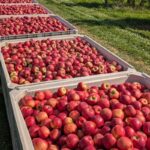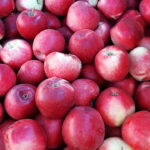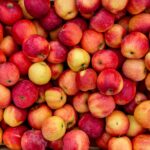Argentine pome fruit set for slight shortfall

Late frosts will cause apple and pear production in the Argentine provinces of Río Negro and Neuquén to fall by 4% and 8% respectively this year, according to estimates from the Argentine Chamber of Integrated Fruit Growers (CAFI). 
CAFI executive director Marcelo Loyarte told www.freshfruitportal.com the areas' production of apples would likely be 890,000 metric tons (MT) while pears were expected to reach 794,000MT.
"It’s been a good year in terms of the weather but the experts have concluded that frosts at the end of August and into early September may have resulted in the production decrease," Loyarte said.
The shortfalls in the apple sector vary according to the production area and variety, Loyarte explained. While Granny Smith output is set to rise by 15% to 189,000MT, Red Delicious and Royal Galas are due to contract by 10% and 2% to 541,000MT and 120,000MT respectively.
Loyarte said the situation for pears was different, however, since volumes of Anjou and Packham’s pears were expected to rise by 10% to 95,000MT and 8% to 266,000MT respectively, while the Williams variety would see a considerable decline of 18% to 338,000MT.
But now that harvesting is well underway, consultancy agency Top Info Marketing has suggested the end results may reveal even higher-than-expected losses.
Top Info's own current predictions for the 2014 crop are very similar to those compiled by CAFI. The agency expects that the Patagonian regions of Río Negro and Neuquén will produce a combined crop of 886,000MT of apples and 778,000MT of pears this year.
In addition, Top Info said apple production in the northern region of Mendoza was forecast to fall by 25% to 53,000MT, with pear output on course to decrease by 30% to 60,00MT.
Although Top Info’s director Betina Ernst agreed that the weather has had a part to play in the production decline, she added that multiple factors have conspired to cause the overall shortfall.
"There isn't one single reason. Although the weather was normal during summer, there were late frosts, problems with pollination, a fairly hot January and a cool spring. Added to that, the external markets aren't looking favourable," Ernst said.
As a result, Top Info expects Argentina will export slightly fewer apples and pears to its largest markets – Europe and Russia – during 2014, while volume shipped to other destinations is due to remain stable.
"Our main markets are looking difficult – both Europe and Russia, as well as the U.S.
"There isn’t a huge amount of interest in our fruit because of the current high volumes of fruit available from the Southern Hemisphere.
"Prices are lower than in 2013 too, although for now they are above the levels achieved in 2012. We shall have to proceed very carefully and try to avoid supplying a large volume to the market."
Loyarte added apple stocks in the Northern Hemisphere were currently 25% higher than last season, while pear stocks were up by a considerable 52%.
All eyes on Asia
With traditional markets proving a challenge year-on-year, Argentina's apple and pear sector has begun to search for new export opportunities.
To that end, the country’s authorities are currently in the process of negotiating direct access to the lucrative consumer markets of China and the Philippines.
"The phytosanitary protocol with China is due to be signed in the next few months," Loyarte confirmed.
"Officials from the Philippine Plant Quarantine Service also visited Argentina recently as a result of a public-private effort to allow the authorities to get to know the production areas and the rigorous controls in Patagonia, which is certified as a fruit-fly-free region."
Loyarte said the importance of the two markets meant Argentina’s apple and pear industry was eager to consolidate a position in the medium term.
Asia represents the future and we want to be one of its principal suppliers. It's an interesting market in terms of volume and consumer trends. But we shall go slowly to ensure a smooth flow of supply.”
While Asia presents good opportunities for the industry, Ernst was quick to point out that it remained a "complicated" market for fresh fruit suppliers.
"We are very far [from Asia] plus it's a new business in which you have to gain experience," she noted.
"For that reason we will start very slowly – there will not be large volumes for now."
Despite the hype surrounding Argentina's interest in Asia, Ernst also said the European market would ultimately remain the industry's main Northern Hemisphere market for apples and pears.
"The ties and commitments are very strong. The opening of new markets [in Asia] will not have a major impact on exports to Europe.
"For now we will continue to send similar volumes to previous years, although this will depend largely on the market situation there of course."
Loyarte agreed that any growth in Argentina’s apple and pear supply to Asia would not impact on available volume for Europe in view of the industry's potential to increase production.
Photo: www.shutterstock.com














































